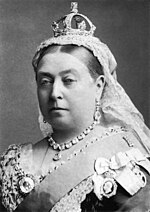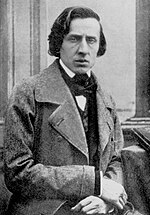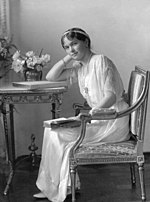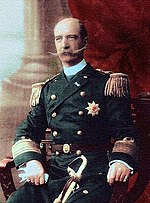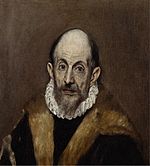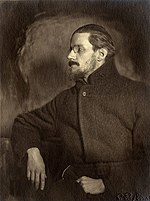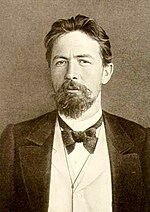Portal:Europe/Featured biography
| This Wikipedia page has been superseded by Portal:Europe and is retained primarily for historical reference. |
| Note: Article entries are now being transcluded directly on the main portal page. However, this page should be retained for historical reference. |
Usage
The layout design for these subpages is at Portal:Europe/Featured biography/Layout.
- Add a new Selected article to the next available subpage.
- Update "max=" to new total for its {{Random portal component}} on the main page.
Selected biographies list
Featured biography 1
Portal:Europe/Featured biography/1
Victoria was Queen of the United Kingdom of Great Britain and Ireland from 20 June 1837 until her death. From 1 May 1876, she adopted the additional title of Empress of India.Victoria was the daughter of Prince Edward, Duke of Kent and Strathearn, the fourth son of King George III. Both the Duke of Kent and King George III died in 1820, and Victoria was raised under close supervision by her German-born mother Princess Victoria of Saxe-Coburg-Saalfeld. She inherited the throne aged 18, after her father's three elder brothers had all died, leaving no surviving legitimate children. The United Kingdom was already an established constitutional monarchy, in which the sovereign held relatively little direct political power. Privately, Victoria attempted to influence government policy and ministerial appointments; publicly, she became a national icon who was identified with strict standards of personal morality.
Victoria married her first cousin, Prince Albert of Saxe-Coburg and Gotha, in 1840. Their nine children married into royal and noble families across the continent, tying them together and earning her the sobriquet "the grandmother of Europe". After Albert's death in 1861, Victoria plunged into deep mourning and avoided public appearances. As a result of her seclusion, republicanism temporarily gained strength, but in the latter half of her reign her popularity recovered. Her Golden and Diamond Jubilees were times of public celebration.
Featured biography 2
Portal:Europe/Featured biography/2
Vincent Willem van Gogh was a Dutch Post-Impressionist painter who is among the most famous and influential figures in the history of Western art. In just over a decade he created about 2100 artworks, including around 860 oil paintings, most of them in the last two years of his life. They include landscapes, still lifes, portraits and self-portraits, and are characterised by bold, symbolic colours, and dramatic, impulsive and expressive brushwork that contributed to the foundations of modern art. He died by suicide at 37, following years of mental illness and poverty.Born into an upper-middle-class family, Van Gogh drew as a child and was serious, quiet and thoughtful. As a young man he worked as an art dealer, often travelling, but became depressed after he was transferred to London. He turned to religion, and spent time as a missionary in southern Belgium. Later he drifted in ill health and solitude. He took up painting in 1881 having moved back home with his parents. His younger brother Theo supported him financially, and the two kept up a long correspondence by letter.
Van Gogh's early works, mostly still lifes and depictions of peasant labourers, contain few signs of the vivid colour that distinguished his later work. In 1886 he moved to Paris where he met members of the avant-garde, including Emile Bernard and Paul Gauguin, who were reacting against the Impressionist sensibility. As his work developed he created a new approach to still lifes and local landscapes. His paintings grew brighter in colour as he developed a style that became fully realised during his stay in Arles in the south of France in 1888. During this period he broadened his subject matter to include olive trees, cypresses, wheat fields and sunflowers.
Featured biography 3
Portal:Europe/Featured biography/3
Honoré de Balzac was a French novelist and playwright. The novel sequence La Comédie Humaine, which presents a panorama of post-Napoleonic French life, is generally viewed as his magnum opus.Owing to his keen observation of detail and unfiltered representation of society, Balzac is regarded as one of the founders of realism in European literature. He is renowned for his multi-faceted characters; even his lesser characters are complex, morally ambiguous and fully human. Inanimate objects are imbued with character as well; the city of Paris, a backdrop for much of his writing, takes on many human qualities. His writing influenced many famous writers, including the novelists Émile Zola, Charles Dickens, Gustave Flaubert, Jack Kerouac, Akira Kurosawa and Henry James, as well as important philosophers such as Friedrich Engels. Many of Balzac's works have been made into films, and they continue to inspire other writers.
An enthusiastic reader and independent thinker as a child, Balzac had trouble adapting to the teaching style of his grammar school. His willful nature caused trouble throughout his life and frustrated his ambitions to succeed in the world of business. When he finished school, Balzac was apprenticed in a law office, but he turned his back on the study of law after wearying of its inhumanity and banal routine. Before and during his career as a writer, he attempted to be a publisher, printer, businessman, critic, and politician; he failed in all of these efforts. La Comédie Humaine reflects his real-life difficulties, and includes scenes from his own experience.
Featured biography 4
Portal:Europe/Featured biography/4
Frédéric François Chopin (March 1810 – 17 October 1849), born Fryderyk Franciszek Chopin, was a Polish composer and virtuoso pianist of the Romantic era who wrote primarily for the solo piano. He gained and has maintained renown worldwide as a leading musician of his era, whose "poetic genius was based on a professional technique that was without equal in his generation." Chopin was born in what was then the Duchy of Warsaw and grew up in Warsaw, which in 1815 became part of Congress Poland. A child prodigy, he completed his musical education and composed his earlier works in Warsaw before leaving Poland at the age of 20, less than a month before the outbreak of the November 1830 Uprising.At 21 he settled in Paris. Thereafter, during the last 18 years of his life, he gave only some 30 public performances, preferring the more intimate atmosphere of the salon. He supported himself by selling his compositions and by teaching piano, for which he was in high demand. Chopin formed a friendship with Franz Liszt and was admired by many of his musical contemporaries, including Robert Schumann. In 1835 he obtained French citizenship. After a failed engagement to Maria Wodzińska, from 1837 to 1847 he maintained an often troubled relationship with the French woman writer George Sand. A brief and unhappy visit to Majorca with Sand in 1838–39 was one of his most productive periods of composition. In his last years, he was financially supported by his admirer Jane Stirling, who also arranged for him to visit Scotland in 1848. Through most of his life, Chopin suffered from poor health. He died in Paris in 1849, at the age of 39, probably of tuberculosis.
Featured biography 5
Portal:Europe/Featured biography/5
Grand Duchess Olga Nikolaevna of Russia (November 15 [O.S. November 3] 1895 – July 17, 1918) was the eldest daughter of the last Tsar of the Russian Empire, Emperor Nicholas II, and of Empress Alexandra of Russia.During her lifetime, Olga's future marriage was the subject of great speculation within Russia. Matches were rumored with Grand Duke Dmitri Pavlovich of Russia, Crown Prince Carol of Romania, Edward, Prince of Wales, eldest son of Britain's George V, and with Crown Prince Alexander of Serbia. Olga herself wanted to marry a Russian and remain in her home country. During World War I, Olga nursed wounded soldiers in a military hospital until her own nerves gave out and, thereafter, oversaw administrative duties at the hospital.
Olga's murder following the Russian Revolution of 1917 resulted in her canonization as a passion bearer by the Russian Orthodox Church. In later years, when dozens of people made claims to be surviving members of the imperial family, a woman named Marga Boodts claimed to be Grand Duchess Olga, but her claim was not taken seriously. Olga was assassinated along with her family at Yekaterinburg. Her remains were identified through DNA testing and were buried during a funeral ceremony in 1998 at Peter and Paul Cathedral in St. Petersburg along with those of her parents and two of her sisters.
Featured biography 6
Portal:Europe/Featured biography/6
Annelies Marie Frank ( 12 June 1929 – February or March 1945) was a German-born diarist and writer. One of the most discussed Jewish victims of the Holocaust, she gained fame posthumously following the publication of her diary, The Diary of a Young Girl (originally Het Achterhuis; 'The Secret Annex' ), which documents her life in hiding from 1942 to 1944, during the German occupation of the Netherlands in World War II. It is one of the world's most widely known books and has been the basis for several plays and films.Born in Frankfurt, Germany, she lived most of her life in or near Amsterdam, Netherlands, having moved there with her family at the age of four-and-a-half when the Nazis gained control over Germany. Born a German national, Frank lost her citizenship in 1941 and thus became stateless. By May 1940, the Franks were trapped in Amsterdam by the German occupation of the Netherlands. As persecutions of the Jewish population increased in July 1942, the family went into hiding in some concealed rooms behind a bookcase in the building where Anne's father worked. From then until the family's arrest by the Gestapo in August 1944, Anne kept a diary she had received as a birthday present, and wrote in it regularly. Following their arrest, the Franks were transported to concentration camps. In October or November 1944, Anne and her sister, Margot, were transferred to Bergen-Belsen concentration camp from Auschwitz, where they died (probably of typhus) a few months later. They were originally estimated by the Red Cross to have died in March, with Dutch authorities setting 31 March as their official date of death, but research by the Anne Frank House in 2015 suggests they more likely died in February.
Featured biography 7
Portal:Europe/Featured biography/7
Mary Wollstonecraft (27 April 1759 – 10 September 1797) was an English writer, philosopher, and advocate of women's rights. During her brief career, she wrote novels, treatises, a travel narrative, a history of the French Revolution, a conduct book, and a children's book. Wollstonecraft is best known for A Vindication of the Rights of Woman (1792), in which she argues that women are not naturally inferior to men, but appear to be only because they lack education. She suggests that both men and women should be treated as rational beings and imagines a social order founded on reason.Until the late 20th century, Wollstonecraft's life, which encompassed several unconventional personal relationships, received more attention than her writing. After two ill-fated affairs, with Henry Fuseli and Gilbert Imlay (by whom she had a daughter, Fanny Imlay), Wollstonecraft married the philosopher William Godwin, one of the forefathers of the anarchist movement. Wollstonecraft died at the age of 38, eleven days after giving birth to her second daughter, leaving behind several unfinished manuscripts. This daughter, Mary Wollstonecraft Godwin, became an accomplished writer herself, as Mary Shelley, the author of Frankenstein.
After Wollstonecraft's death, her widower published a Memoir (1798) of her life, revealing her unorthodox lifestyle, which inadvertently destroyed her reputation for almost a century. However, with the emergence of the feminist movement at the turn of the twentieth century, Wollstonecraft's advocacy of women's equality and critiques of conventional femininity became increasingly important. Today Wollstonecraft is regarded as one of the founding feminist philosophers, and feminists often cite both her life and work as important influences.
Featured biography 8
Portal:Europe/Featured biography/8
George I (24 December 1845 – 18 March 1913) was King of Greece from 1863 until his assassination in 1913.Originally a Danish prince, George was born in Copenhagen, and seemed destined for a career in the Royal Danish Navy. He was only 17 years old when he was elected king by the Greek National Assembly, which had deposed the unpopular former king Otto. His nomination was both suggested and supported by the Great Powers: the United Kingdom of Great Britain and Ireland, the Second French Empire and the Russian Empire. He married the Russian grand duchess Olga Constantinovna of Russia, and became the first monarch of a new Greek dynasty. Two of his sisters, Alexandra and Dagmar, married into the British and Russian royal families. King Edward VII and Tsar Alexander III were his brothers-in-law and King George V and Tsar Nicholas II were his nephews.
George's reign of almost 50 years (the longest in modern Greek history) was characterized by territorial gains as Greece established its place in pre-World War I Europe. Britain ceded the Ionian Islands peacefully, while Thessaly was annexed from the Ottoman Empire after the Russo-Turkish War (1877–1878). Greece was not always successful in its territorial ambitions; it was defeated in the Greco-Turkish War (1897). During the First Balkan War, after Greek troops had captured much of Greek Macedonia, George was assassinated in Thessaloniki. Compared to his own long tenure, the reigns of his successors Constantine, Alexander, and George II proved short and insecure.
Featured biography 9
Portal:Europe/Featured biography/9 Pavle Đurišić (9 July 1909 – April 1945) was a Montenegrin Serb regular officer of the Royal Yugoslav Army who became a Chetnik commander (vojvoda) and led a significant proportion of the Chetniks in Montenegro during World War II. He distinguished himself and became one of the main commanders during the popular uprising against the Italians in Montenegro in July 1941, and later collaborated with the Italians in actions against the Yugoslav Partisans. In 1943, his troops carried out several massacres against the Muslim population of Bosnia, Herzegovina and the Sandžak, and participated in the anti-Partisan Case White offensive alongside Italian forces. Đurišić was captured by the Germans in May 1943, escaped and was recaptured.
After the capitulation of Italy, the Germans released Đurišić and he began collaborating with them and the Serbian puppet government. In 1944, he created the Montenegrin Volunteer Corps with assistance from the Germans, Milan Nedić, and Dimitrije Ljotić. In late 1944, the German commander in Montenegro decorated him with the Iron Cross 2nd Class. Đurišić was killed following the Battle of Lijevče Field, after being captured by elements of the Armed Forces of the Independent State of Croatia near Banja Luka in an apparent trap set by them and Montenegrin separatist Sekula Drljević. Some of Đurišić's troops were killed either in this battle or in later attacks by the Partisans as they then continued their withdrawal west. Others attempted to withdraw to Austria; they were forced to surrender to the Partisans and were killed in the Kočevski Rog area of southern Slovenia in May and June 1945. Đurišić was a very able Chetnik leader; his fighting skills were respected by his allies and opponents alike.
Featured biography 10
Portal:Europe/Featured biography/10
Johannes Kepler was a German Lutheran mathematician, astronomer and astrologer, and a key figure in the 17th century astronomical revolution. He is best known for his eponymous laws of planetary motion, codified by later astronomers based on his works Astronomia nova, Harmonices Mundi, and Epitome of Copernican Astronomy. Before Kepler, planets' paths were computed by combinations of the circular motions of the celestial orbs. After Kepler, astronomers shifted their attention from orbs to orbits—paths that could be represented mathematically as an ellipse. Kepler's laws also provided one of the foundations for Isaac Newton's theory of universal gravitation. During his career Kepler was a mathematics teacher at a Graz seminary school, an assistant to Tycho Brahe, the court mathematician to Emperor Rudolf II, a mathematics teacher in Linz, Austria, and an adviser to General Wallenstein. He also did fundamental work in the field of optics and helped to legitimize the telescopic discoveries of his contemporary Galileo Galilei.
Featured biography 11
Portal:Europe/Featured biography/11
Doménikos Theotokópoulos (1541 – 7 April 1614), most widely known as El Greco, was a painter, sculptor and architect of the Spanish Renaissance.El Greco was born in Crete, which was at that time part of the Republic of Venice, and the center of Post-Byzantine art. He trained and became a master within that tradition before traveling at age 26 to Venice, as other Greek artists had done. In 1570 he moved to Rome, where he opened a workshop and executed a series of works. During his stay in Italy, El Greco enriched his style with elements of Mannerism and of the Venetian Renaissance. In 1577, he moved to Toledo, Spain, where he lived and worked until his death. In Toledo, El Greco received several major commissions and produced his best-known paintings.
El Greco's dramatic and expressionistic style was met with puzzlement by his contemporaries but found appreciation in the 20th century. El Greco is regarded as a precursor of both Expressionism and Cubism, while his personality and works were a source of inspiration for poets and writers such as Rainer Maria Rilke and Nikos Kazantzakis. El Greco has been characterized by modern scholars as an artist so individual that he belongs to no conventional school. He is best known for tortuously elongated figures and often fantastic or phantasmagorical pigmentation, marrying Byzantine traditions with those of Western painting.
Featured biography 12
Portal:Europe/Featured biography/12
James Augustine Aloysius Joyce (2 February 1882 – 13 January 1941) was an Irish novelist and poet. He contributed to the modernist avant-garde and is regarded as one of the most influential and important authors of the 20th century.Joyce is best known for Ulysses (1922), a landmark work in which the episodes of Homer's Odyssey are paralleled in an array of contrasting literary styles, perhaps most prominent among these the stream of consciousness technique he utilised. Other well-known works are the short-story collection Dubliners (1914), and the novels A Portrait of the Artist as a Young Man (1916) and Finnegans Wake (1939). His other writings include three books of poetry, a play, occasional journalism and his published letters.
Joyce was born in 41 Brighton Square, Rathgar, Dublin—about half a mile from his mother's birthplace in Terenure—into a middle-class family on the way down. A brilliant student, he excelled at the Jesuit schools Clongowes and Belvedere, despite the chaotic family life imposed by his father's alcoholism and unpredictable finances. He went on to attend University College Dublin.
Featured biography 13
Portal:Europe/Featured biography/13
Anton Pavlovich Chekhov (29 January 1860 – 15 July 1904) was a Russian playwright and short story writer, who is considered to be among the greatest writers of short fiction in history. His career as a playwright produced four classics and his best short stories are held in high esteem by writers and critics. Along with Henrik Ibsen and August Strindberg, Chekhov is often referred to as one of the three seminal figures in the birth of early modernism in the theatre. Chekhov practiced as a medical doctor throughout most of his literary career: "Medicine is my lawful wife", he once said, "and literature is my mistress."Chekhov renounced the theatre after the reception of The Seagull in 1896, but the play was revived to acclaim in 1898 by Konstantin Stanislavski's Moscow Art Theatre, which subsequently also produced Chekhov's Uncle Vanya and premiered his last two plays, Three Sisters and The Cherry Orchard. These four works present a challenge to the acting ensemble as well as to audiences, because in place of conventional action Chekhov offers a "theatre of mood" and a "submerged life in the text".
Chekhov had at first written stories only for financial gain, but as his artistic ambition grew, he made formal innovations which have influenced the evolution of the modern short story. He made no apologies for the difficulties this posed to readers, insisting that the role of an artist was to ask questions, not to answer them.
Featured biography 14
Portal:Europe/Featured biography/14 Vesna Vulović (Serbian Cyrillic: Весна Вуловић, pronounced [ʋêsna ʋûːloʋitɕ]; 3 January 1950 – 23 December 2016) was a Serbian flight attendant who survived the highest fall without a parachute: 10.16 kilometres (6.31 miles) or 33,338 feet. She was the sole survivor after an explosion tore through the baggage compartment of JAT Flight 367 on 26 January 1972, causing it to crash near Srbská Kamenice, Czechoslovakia (now part of the Czech Republic). Air safety investigators attributed the explosion to a briefcase bomb. The Yugoslav authorities suspected that émigré Croatian nationalists were to blame, but no one was ever arrested.
Following the bombing, Vulović spent days in a coma and was hospitalized for several months. She suffered a fractured skull, three broken vertebrae, broken legs, broken ribs, and a fractured pelvis. These injuries resulted in her being temporarily paralyzed from the waist down. Vulović made an almost complete recovery but continued to walk with a limp. She had little to no memory of the incident and had no qualms about flying in the aftermath of the crash. Despite her willingness to resume work as a flight attendant, Jat Airways (JAT) gave her a desk job negotiating freight contracts, feeling her presence on flights would attract too much publicity. Vulović became a celebrity in Yugoslavia and was deemed a national hero.
Vulović was fired from JAT in the early 1990s after taking part in anti-government protests during the breakup of Yugoslavia, but avoided arrest as the government was concerned about the negative publicity that her imprisonment would bring. She continued her work as a pro-democracy activist until the Socialist Party of Serbia was ousted from power during the Bulldozer Revolution of October 2000. Vulović later campaigned on behalf of the Democratic Party, advocating Serbia's entry into the European Union. Her final years were spent in seclusion, and she struggled with survivor guilt. Having divorced, Vulović lived alone in her Belgrade apartment on a small pension until her death in 2016. (Full article...)
Featured biography 15
Featured biography 16
Featured biography 17
Featured biography 18
Featured biography 19
Featured biography 20
Nominations
Feel free to add Europe related articles Featured articles to the above list.

